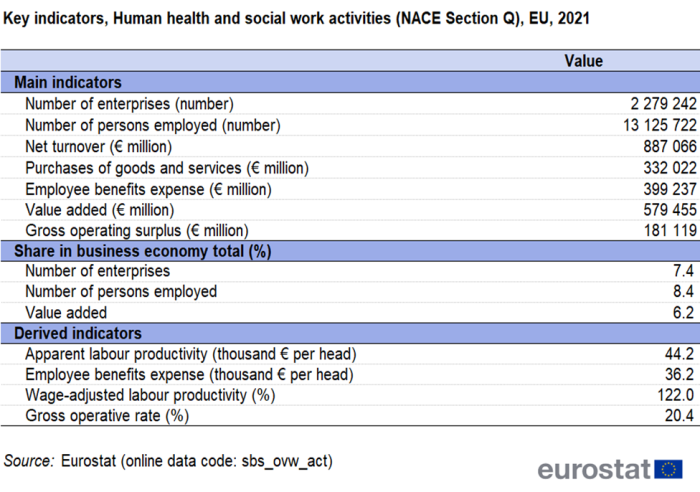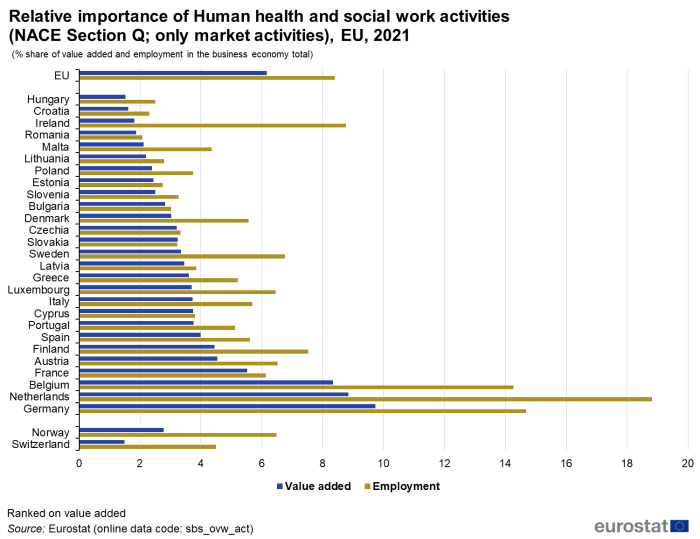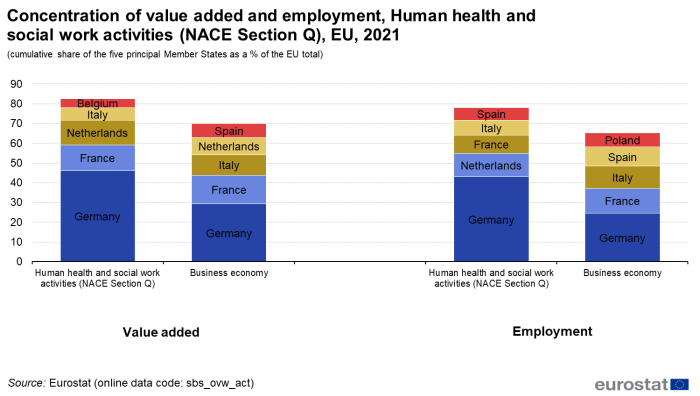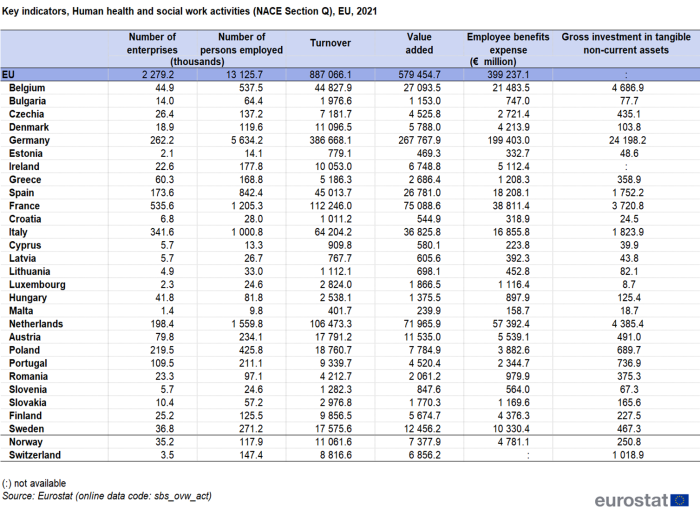Businesses in human health and social work activities sector
Data extracted in March 2024
Planned article update: March 2025
Highlights
13.1 million persons, representing 8.4 % of the workforce in the EU's business economy, were employed in 2021 in businesses in the human health and social work activities sector.
In 2021, businesses in the human health and social work activities sector generated 6.2 % of the EU's value added (€579 billion).
This article presents an overview of statistics on businesses in the European Union's (EU) human health and social work activities sector (hereafter referred to as health and social work), as covered by NACE Rev. 2 Section Q. It belongs to a set of statistical articles on 'Business economy by sector'.
Following the entry into force of the European Business Statistics (EBS) Regulation, Eurostat has extended the service coverage for structural business statistics (SBS) data and is publishing, for the first time, SBS data on the human health and social services sector. Additional information on health is also available from other data collections such as health statistics.
Full article
Structural profile
In 2021, there were 2.3 million enterprises classified within the EU's human health and social work activities sector (Section Q), which represented 7.4 % of all enterprises active in the business economy (Sections B to N and P to R, as well as Divisions S95 and S96). These enterprises employed 13.1 million persons, generating €579.5 billion in value added and accumulating a net turnover of €887.1 billion.
The EU's human health and social work activities sector contributed 8.4 % of all persons employed in the business economy in 2021, and accounted for 6.2 % of the value added.
SBS only cover the activities of market producers. Contrary to most activities covered by SBS, non-market producers represent a significant part of the human health and social work activities sector (and also for example the education sector). It should be noted that the data in this article only cover the market producers, meaning those acting under market conditions, active in this sector.

Source: Eurostat (sbs_ovw_act)
The apparent labour productivity recorded in the human health and social work activities sector in 2021 was €44 200 per person employed, indicating a difference of €32 700 from the business economy average of €60 200 per employee. The average employee benefits expense within the human health and social work activities sector stood at €36 200 per employee, quite close to the business economy average of €39 000 per person employed. By combining these two ratios into wage-adjusted labour productivity ratio, it shows the extent to which value added per person employed covers average personnel costs per employee. In 2021, the human health and social work activities sector recorded a wage-adjusted labor productivity ratio of 122.0 %, below the EU average of 154.4 %. On the other hand, the gross operating rate, representing the share of turnover remaining after covering for purchased goods and services as well as employee benefits expense (commonly known as the gross operating surplus) stood at 20.4 % for the EU's human health and social work activities sector in 2021. This figure surpassed the 13.2 % average of gross operating rate for the business economy. This indicates that the share of total purchases of goods and services is relatively low in the human health and social work activities sector compared with other economic activities.
Sectoral analysis
The human health and social work activities sector is organized into three NACE divisions: human health activities (Division 86), residential care activities (Division 87) and social work activities without accommodation (Division 88). As mentioned in the introduction, SBS cover only the market producers in the health and social workal sector, i.e. those acting under market conditions.
In 2021, more than two thirds of the EU's value added in the human health and social work activities sector were recorded in the subsector of human health activities (Division 86). This covers hospital activities, medical and dental practices activities and other human health activities, like speech therapy, homeopathy or acupuncture, among others— see Figure 1. Among the other three subsectors, this one employed also the highest number of persons, more than half of the whole sector of human health and social work activities.

(% share of sectoral total)
Source: Eurostat (sbs_ovw_act)
In 2021, this subsector comprised 2.1 million enterprises and a workforce of 8.1 million persons, contributing to the EU's business economy with a value added of €421.3 billion. This positioned the division of human health activities (only market activities) in the fourth place in terms of employment and value added among all the other NACE subsectors within the business economy. The subsector of residential care activities (Division 87) recorded the least number of enterprises among the three subsectors, 37 200. Despite the low number of enterprises, it employed 2.6 million persons, as seen in Table 2a. This division includes the provision of residential care combined with nursing, personal care services for elderly and disabled and for people with mental retardation, mental health and substance abuse as well as people who are unable to fully care for themselves or who do not desire to live independently. It was followed by the subsector of social work activities without accommodation (Division 88), which includes visiting, day-care and similar activities for the elderly or for disabled adults and activities of day nurseries for pupils, including day-care activities for disabled children. In this subsector (only market activities), there were 166.7 thousand enterprises active in 2021, which employed 2.4 million people and generated €67.5 million in value added.

Source: Eurostat (sbs_ovw_act)

Source: Eurostat (sbs_ovw_act)
In 2021, apparent labour productivity within the EU's health and social work subsectors ranged from €28 100 per person employed for social work activities without accommodation to €51 900 for human health activities. The subsector of human health activities recorded also the highest average employee benefits expense among the EU's human health and social work activities sector, at €40 700 per employee. Following closely was the subsector of residential care activities, reporting an average of €33 300 in employee benefits— see Table 2b.
Country overview
Across EU countries the SBS data on the human health and social work activities sector showed varying contributions to the value added of the business economy, with an average of 6.2 % at the EU level. At the higher end of the scale, it stood at 9.7 % in Germany, 8.8 % in the Netherlands, and 8.3 % in Belgium. On the other hand, Hungary (1.5 %), Croatia (1.6 %), and Ireland (1.8 %) were at the lower end of the scale. In terms of employment, the sector's contribution to the business economy stood at an average of 8.4 % in the EU. This has varied from 2.1 % in Romania, 2.3 % in Croatia and 2.5 % in Hungary to 14.3 % in Belgium, 14.7 % in Germany and has reached the highest share at 18.8 % in the Netherlands.

(% share of value added and employment in the business economy total)
Source: Eurostat (sbs_ovw_act)
In terms of the contribution made by the five largest EU Member States, Germany had the highest contribution in both value added and employment terms in 2021, accounting for 46.2 % of the EU valued added and 42.9 % of the EU employment of market activities in the human health and social work activities sector in 2021. Both values significantly surpassed the shares of value added and employment within the EU's business economy as a whole. With a much lower value than Germany, the second-highest share of value added in the human health and social work activities sector (only market activities) was recorded by France, while the Netherlands placed third. The order has reversed in terms of employment. The contribution of the top 5 countries in the human health and social work activities sector accounted for 77.9 % of the value added and 71.6 % of employment— see Figure 3.

(cumulative share of the five principal Member States as a % of the EU total)
Source: Eurostat (sbs_ovw_act)

Source: Eurostat (sbs_ovw_act)
In value added terms, Germany was the largest EU Member States in all three subsectors in 2021 (see Table 3), the highest share being in human health activities (33.7 % of the EU value added). Within the same subsector, Germany recorder the highest degree of specialization, while for the other two subsector, the Netherlands emerged as the most specialized country. As seen in Table 4, in absolute terms, Germany recorded the highest level of value added (€267.8 billion) and of turnover (€386.7 billion) within the human health and social work activities sector in 2021. Germany also employed the highest number of persons within the human health and social work activities sector in 2021, 5.6 million persons and was followed by the Netherlands (1.6 million persons), France (1.2 million persons) and Italy (1.0 million persons).

Source: Eurostat (sbs_ovw_act)
Source data for tables and graphs
Data sources and availability
Coverage
Human health and social work activities sector includes activities of short- or long-term hospitals, general or specialty medical, surgical, psychiatric and substance abuse hospitals, sanatoria, preventoria, medical nursing homes, asylums, mental hospital institutions, rehabilitation centers, leprosaria and other human health institutions which have accommodation facilities and which engage in providing diagnostic and medical treatment to patients with any of a wide variety of medical conditions. It also includes medical consultation and treatment in the field of general and specialised medicine by general practitioners and medical specialists and surgeons. It includes dental practice activities of a general or specialised nature and orthodontic activities. Additionally, it includes activities for human health not performed by hospitals or by practicing medical doctors but by paramedical practitioners legally recognised to treat patients.
SBS only cover the activities of market producers. Contrary to most activities covered by SBS, non-market producers represent a significant part of the human health and social work activities sector (and also for example the education sector). It should be noted that the data in this article only cover the market producers, meaning those acting under market conditions, active in this sector.
The activities covered by human health and social work activities sector are categorized as follows:
- hospital activities (Division 86)
- hospital activities (Division 861)
- medical and dental practice activities (Division 862)
- other human health activities (Division 869)
This division covers activities of short- or long-term hospitals, general or specialty medical, surgical, psychiatric and substance abuse hospitals, sanatoria, preventoria, medical nursing homes, asylums, mental hospital institutions, rehabilitation centres, leprosaria and other human health institutions which have accommodation facilities and which engage in providing diagnostic and medical treatment to inpatients with any of a wide variety of medical conditions. It also includes medical consultation and treatment in the field of general and specialised medicine by general practitioners and medical specialists and surgeons. It includes dental practice activities of a general or specialised nature and orthodontic activities. Additionally, this division includes activities for human health not performed by hospitals or by practicing medical doctors but by paramedical practitioners legally recognised to treat patients.
- residential care activities (Division 87)
- residential nursing care activities (Division 871)
- residential care activities for mental retardation, mental health and substance abuse (Division 872)
- residential care activities for elderly and disabled (Division 873)
- other residential care activities (Division 879)
- post-secondary non-tertiary health and social work
This division includes the provision of residential care combined with either nursing, supervisory or other types of care as required by the residents. Facilities are a significant part of the production process and the care provided is a mix of health and social services with the health services being largely some level of nursing services
- social work activities without accommodation (Division 88)
- social work activities without accommodation for the elderly and disabled (Division 881)
- other social work activities without accommodation (Division 889) – for example child day-care activities
This division comprises the provision of a variety of social assistance services directly to clients. The activities in this division do not include accommodation services, except on a temporary basis.
Data sources
Structural business statistics cover the 'business economy', which includes industry, construction and many services (NACE Rev. 2 sections B to N, P to R as well as division S95 and S96). Structural business statistics do not cover agriculture, forestry and fishing, nor public administration.
Structural business statistics describe the business economy through the observation of units engaged in an economic activity; the unit in structural business statistics is generally the enterprise. An enterprise carries out one or more activities, at one or more locations, and it may comprise one or more legal units. Enterprises that are active in more than one economic activity (plus the value added and turnover they generate, the people they employ, and so on) are classified under the NACE heading corresponding to their principal activity; this is normally the one which generates the largest amount of value added.
The analysis presented in this article is based on the main dataset for structural business statistics (SBS), size class data and regional data, all of which are published annually. SBS only cover the activities of market producers, meaning those acting under market conditions. Contrary to most activities covered by SBS, non-market producers represent a significant part of the human health and social work activities sector.
The main series provides information for each EU Member State as well as a number of non-EU member countries at a detailed level according to the activity classification NACE. Data are available for a wide range of variables.
In structural business statistics, size classes are generally defined by the number of persons employed. A limited set of the standard structural business statistics variables (for example, the number of enterprises, turnover, persons employed and value added) are analysed by size class, mostly down to the three-digit (group) level of NACE. The main size classes used in this article for presenting the results are:
- small and medium-sized enterprises (SMEs): with 1 to 249 persons employed, further divided into
- micro enterprises: with less than 10 persons employed;
- small enterprises: with 10 to 49 persons employed;
- medium-sized enterprises: with 50 to 249 persons employed;
- large enterprises: with 250 or more persons employed.
Structural business statistics also include regional data. Regional SBS data are available at NUTS levels 1 and 2 for most of the EU Member States, Iceland and Norway, mostly down to the two-digit (division) level of NACE. The main variable analysed in this article is the number of persons employed. The type of statistical unit used for regional SBS data is normally the local unit, which is an enterprise or part of an enterprise situated in a geographically identified place. Local units are classified into sectors (by NACE) normally according to their own main activity, but in some EU Member States the activity code is assigned on the basis of the principal activity of the enterprise to which the local unit belongs. The main SBS data series are presented at national level only, and for this national data the statistical unit is the enterprise. It is possible for the principal activity of a local unit to differ from that of the enterprise to which it belongs. Hence, national SBS data from the main series are not necessarily directly comparable with national aggregates compiled from regional SBS.
Direct access to
- Recent Eurostat publications on SBS
- Key figures on Europe – 2023 edition – see subchapter on Business
- Eurostat's Regional Yearbook – see chapter 8. Business
- News Release SBS – 2021 final data
Glossary
ESMS metadata files
- Structural business statistics – SBS metadata file